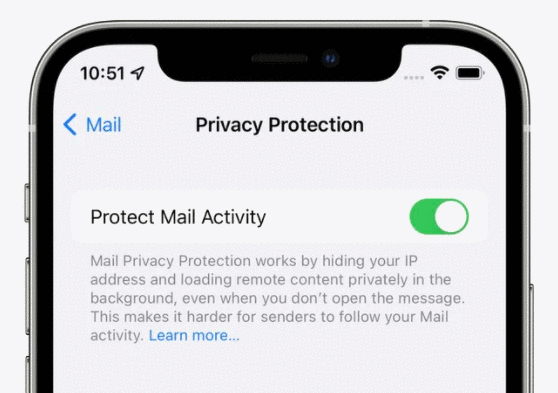What is Apple Mail Privacy Protection?
Apple Mail Privacy Protection (MPP) is a feature available to Apple Mail users. MPP protects a user’s privacy by preventing email marketers from collecting data about the user’s email activity.
Apple MPP was released in September of 2021 as part of iOS 15, iPadOS 15, and MacBook Monterey OS. Apple Mail users can opt-in or out of MPP.
Apple Mail can be used with several email programs including iCloud, Microsoft Exchange, Google/Gmail, Yahoo, AOL, and Outlook.com. Apple MPP does not impact emails opened within the email platform’s native application or through a web browser. For example, opening a Gmail email from within the Gmail client on an iPhone or iPad.
The two primary features of Apple MPP that impact email marketing include:
- Hiding the IP address of the email recipient
- Apple cache servers cache email contents including all images

How does Apple MPP work?
Each email sent by WhatCounts includes a 1×1 pixel image known as a tracking pixel. Typically, the image is downloaded and processed by the user’s email client when the email is opened. Data is sent back to WhatCounts via the tracking pixel indicating the date/time the email was opened and includes user data like: IP address, device type, browser, and mail client based on the user-agent string.
If a user chooses to opt-in to Apple MPP, their email is essentially opened by Apple MPP cache servers. Data is still sent back, but instead of WhatCounts receiving user data, the data will reflect the IP Address of an Apple cache server with a generic device type. If the user does eventually open the email in client, content is retrieved from cache servers and subsequent open data may not be sent to WhatCounts.
Since September of 2021, WhatCounts’ customers have seen increased but inflated open rates on campaigns sent to subscribers who use Apple Mail with MPP enabled. The IP addresses sent back with these open events are those of Apple cache servers, not the subscriber’s device.
How will Apple MPP impact email marketing?
According to Litmus, Apple Mail accounted for 51.4% of the email market share in November 2021. This is an increase from 38.9% in April 2021.
Email Client Market Share in October 2021: Updates and More – Litmus
Email client market share in 2021: Trends from January to March – Litmus
iOS 15 adoption rates so far:
- 24% in November 2021
- 48% in December 2021
- 62% in January 2022
The Open Rate Chokes: Apple MPP Obstructs Its Use As A Metric 11/15/2021 (mediapost.com)
Upsetting The Apple Cart: Tips On How To Cope With Mail Privacy Protection 12/02/2021 (mediapost.com)
Apple: iOS 15 now installed on more than 60% of all iPhones | Computerworld
The impact on open data will be significant and will also affect areas such as:
- A/B Testing
- Automation
- Subscriber list hygiene
- Re-engagement/inactive subscriber campaigns
Recommendations to adapt your email marketing strategy
Apple MPP is here to stay. Following are several recommendations for email marketers ready to adapt and succeed:
Focus on Clicks
Click tracking is still useful and is now the preferred option. Whether it is A/B Testing or Automation, clicks can tell you which test email is preferred or when it is time to send the next email.
Integrate calls-to-action within your emails to urge users to take the next step. This can be encouraged by using shorter and more concise emails. Pivot efforts to focus on click rates over open rates.
A/B Testing
WhatCounts recommends setting A/B Test Definitions to use unique click rate instead of unique open rate.
Automation Campaigns
Much like A/B Testing, when it comes to Automation Campaigns, the recommended course of action is to change the trigger from opened—or similar opened related actions—to clicked only.
Re-engagement
Previously, email marketers sent re-engagement campaigns to users who had not opened or clicked a message within a certain period. Now it is necessary to change the approach—changing re-engagement campaigns to encourage the subscriber to click not just open.
Another customer engagement option is to add SMS. Find more information about the WhatCounts SMS feature at New Feature For Email Marketers: SMS Capabilities (whatcounts.com) or contact sales-team@whatcounts.com.
Beyond the Open Metric
When measuring the success of an email marketing program it is important to consider all the metrics available:
- Clicks
- List Growth
- Churn and Retention Rates
- Bounce Rates
- Email Signup Rate
Email Deliverability
The WhatCounts Deliverability team—led by Chris Truitt, Director of Deliverability—offers a variety of services for email marketers. One of these is inbox monitoring which helps senders identify where emails land (inbox or junk) for top ISPs and mail providers. For details about our services check out https://www.whatcounts.com/services/deliverability-services/.
WhatCounts’ Feature Updates – Coming Soon
- Campaign Details Page: Provide Apple MPP related statistics to help users better understand open tracking data.
- Campaign Report Wizard: Update data available in this report to help users identify Apple MPP generated opens.
- Segmentation: Create segmentation rules that include or exclude browser opens generated by Apple cache servers.






